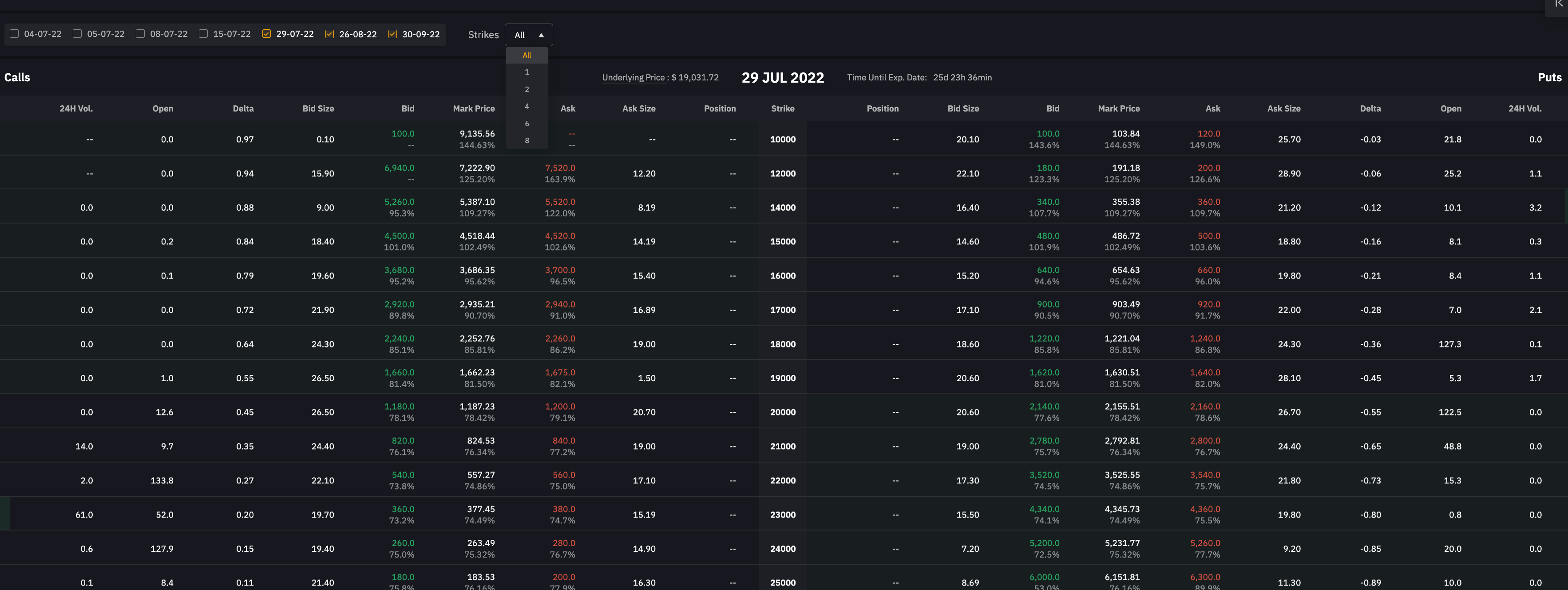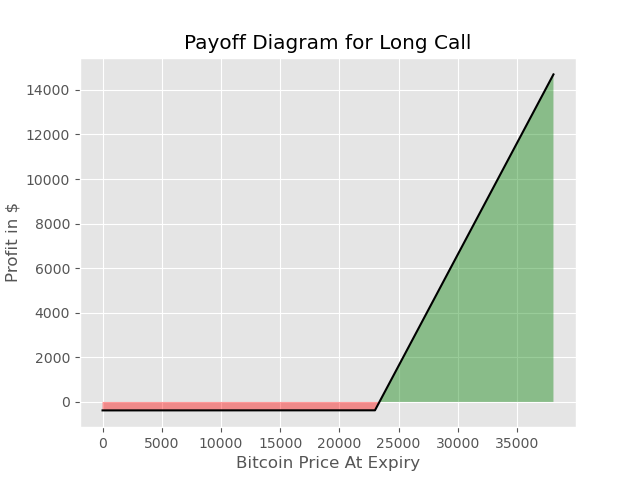Are you looking to take your cryptocurrency trading to the next level? Look no further than Bybit, the leading crypto derivatives exchange. With advanced trading tools, low fees, and a user-friendly platform, Bybit makes it easy to trade Bitcoin, Ethereum, and other popular cryptocurrencies. And if you sign up using our affiliate link through Codearmo and use the referral code CODEARMO, you'll receive exclusive benefits and bonuses up to $30,000 to help you get started. Don't miss out on this opportunity to join one of the fastest-growing communities in crypto trading. Sign up for Bybit today and start trading like a pro!
Users who sign up through the referal link above will also get access to a members only Discord group to ask questions and talk strategies and deployment.

What is a Call Option?
Certainly! A call option is a financial contract that gives the holder (buyer) the right, but not the obligation, to buy an underlying asset at a predetermined price (strike price) within a specified period of time (expiration date). The underlying asset can be a stock, commodity, index, or even a cryptocurrency.
Here are some key terms related to call options:
-
Buyer/Holder: The individual or entity who purchases the call option. They have the right to exercise the option.
-
Seller/Writer: The individual or entity who sells the call option. They have the obligation to fulfill the terms of the option if the buyer exercises it.
-
Strike Price: The predetermined price at which the underlying asset can be bought (in the case of a call option) or sold (in the case of a put option). It is specified when the option is created.
-
Expiration Date: The date at which the option contract expires and becomes invalid. After this date, the option can no longer be exercised.
-
Premium: The price paid by the buyer to the seller for acquiring the option. It represents the value of the contract and is determined by various factors such as the underlying asset price, time to expiration, market volatility, and interest rates.
When a trader purchases a call option, they are essentially betting that the price of the underlying asset will rise above the strike price before the expiration date. If the price of the asset exceeds the strike price, the buyer can choose to exercise the option and buy the asset at the strike price. They can then either sell the asset at a higher market price to make a profit or hold onto it.
Options can be complex financial instruments, and it's advisable to fully understand their mechanics and associated risks before engaging in options trading.
The Bybit Options chain will look something similar to the image below, albeit with updated data, on the tab next to it you will find the Eth options chain.

Let's take an example of a call trade from the options chain above, a trader is bullish on Bitcoin, therefore he goes to Bybit, and decides on buying a 23,000 strike call. What are the immediate results of this trade? He will pay 380 USDC + fees and now have the right to buy Bitcoin at 23,000 USDC on the expiry date, in this case 29th July 2022, we see from the top tab that there are approximately 26 days remaining on this contract.
When the expiry day arrives the trader will get the difference between Bitcoin price on 29th July and 23,000. If the price of Bitcoin is less than 23,000 he will lose his entire investment of 380 USDC. The plot below shows his payoff on the 29th July. Notice the red shaded region which shows the range of prices at which the trader will lose his entire investment.

Option PNL Calculator
Break-even Point for a Call Option
At what point will the trader in the example above, make a profit? Well, if the price is above 23,000 + 380 (price he paid for option) , then he will make a profit. As we see from the plot above
The general case for the breakeven price of a call is as follows:
Breakeven Price = Strike + Call Premium
Pricing Call Options on Bybit
There are a number of important parameters to consider when buying / selling a call option. For a more in-depth look at how options are priced see this article on the Black-Scholes model.
Spot Price
The spot price represents the current price of the asset, you can find the current spot price immediately to the left of the expiry date (29 JULY 2022) , it will be beside 'underlying price' which in this case is 19035USDC.
Strike Price
As discussed previously the strike price is the price at which you are able to buy / forced to sell as the option buyer / sell respectively.
Time to Expiration
The time to expiration must be in a fraction form where the denominator is the number of years as shown below where we use days as an example.
Lets say there are 26 days left in the life of the option, the method for obtaining the time-to-expiration variable as an appropriate input to the Black-Scholes formula is as follows:
\(\frac{days}{365} = \frac{26}{365} \approx 0.072\)
Black-Scholes Time Converter
The risk free interest rate
The risk free is an annual interest rate used in the Black-Scholes model, I guess it would be suitable to set this rate to zero. However, it may be interesting to input a trading view in to this field e.g. we expect Bitcoin to go up 30% per year , we could then insert 0.3 in to the Black-Scholes calculator below.
Volatility
In the context of the Black-Scholes formula, volatility refers to the statistical measure of the magnitude of price fluctuations or variability of an underlying asset, such as a stock or index. It quantifies the level of uncertainty or risk associated with the price movement of the asset.
Volatility is an essential input in the Black-Scholes option pricing model because it helps estimate the potential range of future price movements of the underlying asset. The formula assumes that the price of the underlying asset follows a log-normal distribution and that volatility remains constant over the option's life.
You can see the latest volatility numbers for options quoted as a % rate. For the Black-Scholes formula we need to set this as a decimal so for example 70% = 0.7 , 100% = 1 etc. Also note these numbers are quoted as an annual rate. This article has a nice explanation for how to convert these rates to an annual rate.
You can try looking at the latest Bybit Options and typing in the variables described above to see if the prices match, or potentially look in to modifying the variables to see how they change the theoretical value of the option.
Black-Scholes Option Pricing Calculator
Pros and Cons of Buying Call Options
| Pros | Cons |
|---|---|
| Leverage potential | Limited time |
| Defined risk | Volatility risk |
| Upside potential | Decay |
| Diversification | Complexity |
| Flexibility | Counterparty risk |
Pros:
- Leverage: Call options allow you to control a larger amount of Bitcoin with a smaller investment. This leverage can amplify potential profits if the price of Bitcoin rises significantly.
- Limited risk: With call options, your risk is limited to the premium (price) you pay for the option. Even if the price of Bitcoin falls, your loss is limited to the initial investment.
- Upside potential: Call options give you the right, but not the obligation, to buy Bitcoin at a predetermined price (strike price) within a specific timeframe (expiration). If the price of Bitcoin rises above the strike price, you can benefit from the price increase.
- Diversification: Options can provide an additional way to diversify your investment portfolio and hedge against potential price fluctuations in Bitcoin.
- Flexibility: Options provide flexibility in terms of trade execution. You can choose different strike prices and expiration dates to align with your trading strategy and market expectations.
Cons:
- Limited time: Options have an expiration date, and if the price of Bitcoin doesn't move as anticipated before the expiration, the option may expire worthless, resulting in a loss of the premium paid.
- Volatility risk: Bitcoin is known for its price volatility. While volatility can present opportunities for option traders, it can also lead to rapid price changes and increased risk.
- Decay: Options experience time decay, which means their value decreases as the expiration date approaches. If the price of Bitcoin remains stagnant, the value of the call option may decline over time.
- Complexity: Options trading can be complex, especially for inexperienced traders. It involves understanding concepts such as strike prices, expiration dates, implied volatility, and option pricing models.
- Counterparty risk: When trading options, you are relying on the counterparty to fulfill their obligations. This includes the option writer's ability to deliver Bitcoin if the option is exercised.
It's important to note that options trading involves risks, and it's advisable to thoroughly educate yourself about options and consider your risk tolerance and investment goals before engaging in options trading. Consulting with a financial advisor or professional is also recommended.